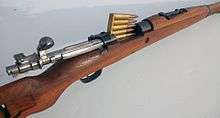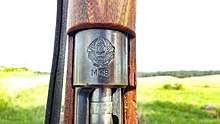Zastava M48
The Zastava M48 (Serbo-Croatian: Puška M.48 7,9 mm / Пушка M.48 7,9 mm, "Rifle M.48 7.9 mm") is a post World War II Yugoslav version of the German Karabiner 98k designed by Mauser and the Belgian designed M24 series. It was the standard service rifle of the Yugoslav People's Army from the early 1950s until its replacement by the Zastava M59/66, a licensed copy of the Soviet SKS semiautomatic carbine, in the early 1960s.
| Puška M.48 7,9 mm (Rifle M.48 7.9 mm) | |
|---|---|
| Type | Bolt-action rifle |
| Place of origin | Yugoslavia |
| Service history | |
| In service | 1950–present |
| Used by | See Users |
| Wars | Lebanese Civil War Yugoslav Wars |
| Production history | |
| Designed | 1948 |
| Produced | 1950–1965 |
| No. built | 1,224,000+ |
| Variants | M48, M48A, M48B, M48BO |
| Specifications | |
| Mass | 3.9 kg (8.6 lb) |
| Length | 1105 mm (43.5 in) |
| Barrel length | 597 mm (23.25 in) |
| Cartridge | 7.92×57 mm IS (8 mm Mauser) |
| Action | Bolt action |
| Muzzle velocity | 760 m/s (2,493 ft/s) |
| Effective firing range | 500 m (547 yd) (with iron sights) 800+ m (875 yd) (with optics) |
| Feed system | 5-round stripper clip, internal box magazine |
| Sights | rear: standard V-notch, adjustable to 2,000 meters in 100 m increments front: hooded, inverted V |
History
After World War II, Yugoslavia took the design of the 98k rifle series and produced its own domestic variant with minor modifications. Although very similar in external appearance, many of the parts of the Yugoslav and German rifles are not interchangeable,[1] especially the bolt and related action parts. M48s are usually distinguished from the 98k by the top handguard, which extends behind the rear sight and ends just in front of the receiver ring, although this feature exists on other models as well. The M48 was designed with a stock similar to the 98k, but it has a shorter intermediate-length action and receiver, as does the similar M24 series Mauser. The M24 series Mausers were built from prewar Yugoslav Model 24 Mausers and then refurbished with newer Belgian parts, and usually have straight bolts, while the M48s have curved bolts. Most M48 stocks are made from thicker Elm or Beech wood and have a thick stainless steel butt plate at the rear of the stock. The M24/47 stocks are mostly made of thinner Walnut or Beech wood and do not have a milled stainless steel "cupped" butt plate. The M48 was also designed to remove the follower from stopping the bolt from closing when the magazine is empty. M48's are regarded as a military surplus firearm and can be collected in the United States, Canada and Australia at a generally cheap price due to the plentiful numbers recently imported from Europe, most of which had never been used in combat.
Variants
There are five main versions of the M48.
M48: 1950-1952- The initial version of the M48, with full crest and all machined steel parts.


M48A: 1952-1965- Inclusion of stamped parts. the M48A used sheet metal stampings for the magazine floor plate. These changes sped production while lowering cost.[2] The critical bolt and receiver which contain the pressure of the burning propellant within the cartridge case retained the same material requirements and design tolerances (i.e. were machined from forged steel) in the A and B variations.
M48B: 1956-1965- Additional sheet metal stampings incorporated. The most critical factor to understand about this model is that it continued to be stamped on the receiver ring M48A. There was no change in markings. The specific changes in parts is unverified but include stamped barrel and H-bands and the magazine spring follower. The most significant change and external appearance whereby the M48B may be identified is the trigger guard. Whereas previously, the trigger guard/mag well were machined from a solid billet of steel, it was changed to an assembly fabricated from stamped parts. The new trigger guard has a rib running around the exterior of both sides. While the exact number of changes made to this model have not been specified, the impact on production in 1956 were extensive and drastically reduced the number produced that year. There was a specific reason for this. From 1956 on, all M48 production was intended solely for export.
M48BO: 1956-1965- The "bo" stands for "bez oznake" and translates roughly as "unmarked" or "without markings." These were identical to and manufactured concurrent with the crested M48B but were not stamped with any national or manufacturer's markings.
M48/63: Zastava Arms manufactured the M48/63 sporting rifle which is a short barreled variant of the Model 1948 rifle.[3] The production stopped as of 2013.
Combat use
Most M48s that are encountered in the United States and Australia today show only slight wear—usually from storage. Many rifles are sold with accessories, including bayonet, bayonet scabbard, leather bayonet frog, ammo pouches, cleaning rod, and field cleaning kit. The rifles are normally sold coated in the protective grease 'cosmoline' which needs to be cleaned out before the rifle is fired. The condition is frequently excellent due to a Yugoslavian maintenance program that cleaned and inspected the stored rifles in rotation every 5 years until that nation's breaking up.
As such, the M48 saw use in the Yugoslav Wars, thousands being used by various militias[4] or paramilitary forces.[5] Often the M48 was used as the basis for a sniper rifle, drilled and tapped for the ZRAK 4x32 telescopic sight and mounts.[6] However, other than an experimental batch of approximately 4000 rifles, no official M48 sniper rifle was ever fielded by the Yugoslav Army.[7]
Egypt bought M48As to diversify its suppliers in the 1950s.[8] Syria purchased M48A[9] and M48BO rifles.[10] Indonesia, Iraq, Burma, Algeria and Chad also received some.[2] In the 1980s, Syria sent surplus M48s to pro-Syrian Lebanese factions during the Lebanese Civil War.[11]
In 2018 Polish Border Guard obtained 44 rifles for ceremonial purposes due to its physical similarities with Polish pre-WW2 Kb wz. 98a.[12]
Users
References
- Ball 2011, p. 332.
- Scarlata, Paul (October 15, 2013). "Yugoslavian M48A | Yugo M48A Mauser Rifle". Military Surplus Magazine.
- "SPORTING RIFLE M48/63". Archived from the original on March 10, 2012.
- Grant, Neil (2015). Mauser Military Rifles. Weapon 39. Oxford: Osprey Publishing. p. 50. ISBN 9781472805966.
- Krott, Rob (October 2003). "Macedonia's Weaponry: A New Nation Re-Arms and Fights". Small Arms Review. Vol. 7 no. 1.
- M48 Mauser Sniper Rifle
- Serbian & Yugoslav Mauser Rifles by Branko Bogdanovic, North Cape Publishing, 2005
- Scarlata, Paul (March 2013). "Military rifle cartridges of Egypt from Khartoum to the Sinai". Shotgun News.
- Ball 2011, p. 369.
- Philip Peterson (20 July 2011). Standard Catalog of Military Firearms: The Collector's Price and Reference Guide. Gun Digest Books. p. 160. ISBN 1-4402-1451-4.
- JWH1975 (June 23, 2017). "Syrian Civil War: WWII weapons used". WII After WII. WordPress. Retrieved April 6, 2018.
- Wilk, Remigiusz (30 October 2018). "Mausery w Nowym Sączu". milmag.pl (in Polish).
- Ball, Robert W. D. (2011). Mauser Military Rifles of the World. Iola: Gun Digest Books. ISBN 9781440228926.CS1 maint: ref=harv (link)
- The Serbian & Yugoslav Mauser Rifles, Branko Bogdanovic, North Cape Publishing, 2005
- Personal communication with the author, Branko Bogdanovic.
- Article, The Anonymous Yugo- The M48B, Military Rifle Journal, July 2008, Michael Cornell & James Golub
External links
| Wikimedia Commons has media related to Zastava M48. |